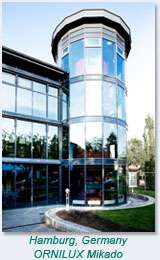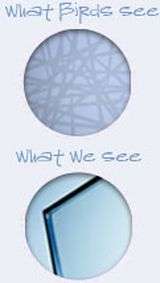August 13, 2012 weblog
Birds can see web-inspired Ornilux glass

(Phys.org) -- A special type of glass that can prevent birds from flying into it has been put to use in the UK at a lookout tower off the north-east coast of England. The special bird stopping glass was developed by a German company and is inspired by nature’s own spiders and the webs they weave—in particular, the orb-weaver spider. The lookout tower at Lindisfarne has installed the special glass to protect the hundreds of species that flock to the island. The human population witnesses a massive increase in bird population at certain times of the year. Authorities wanted to do something to avert the dangers of birds flying into glass.
About 300 species of birds can be found on the island at certain times of the year.
In nature, the orb-weaver spider’s web reflects UV light that protects it from being destroyed by birds. The birds can see it and do not fly through. Similarly, the protective glass coating that is being used in the UK helps birds see the glass. Otherwise, they just see sky and landscape but are not aware of any glass barriers.
The Ornilux glazing reflects ultraviolet light that they can see but humans cannot unless standing up close to the glass. The special protector was developed by German company Arnold Glas and the result is called Ornilux Bird Protection Glass. The glass has a patterned, UV reflective coating, a web of lines coated on to the surface of the glass. The pattern looks like scattered sticks. Standing very close to the glass at a certain angle the human eye can see the fine veins running through it and this is what the birds see if they fly near the tower.

Tests suggest the coating works and the special glass can cut bird strikes. The company tested the Ornilux glass at a flight tunnel at a US nature reserve. Birds were encouraged to fly to the end of the facility which was covered with two types of glass - one containing the special coating, the other without. A net was used and no birds were injured. The experiment suggested that the innovation would prevent birds flying into coated glass in 66 to 68 percent of cases. Other Ornilux users include a wildlife center in Canada, a zoo in Germany, a mountain railway building in Austria, and a school in the U.S. An Arnold Glas source said she hoped more developers and architects look for ways to be more bird-friendly with their designs.
Arnold Glas plans to work up a next-generation product to add solar controlling properties to the coating to help reflect heat.
An estimated 250 million birds in Europe die by flying into glazing in homes and office blocks. Among the various research bodies, estimated numbers are quite remarkable. The commonly quoted toll is estimated to be from 300 million to I billion birds that die each year from collisions with glass on buildings, ranging from skyscrapers to homes. Even if a collision temporarily stuns a bird that soon flies off, scientists say that many times these birds die later from internal bleeding or hematomas, especially on the brain.
More information: www.ornilux.com/
© 2012 Phys.Org



















